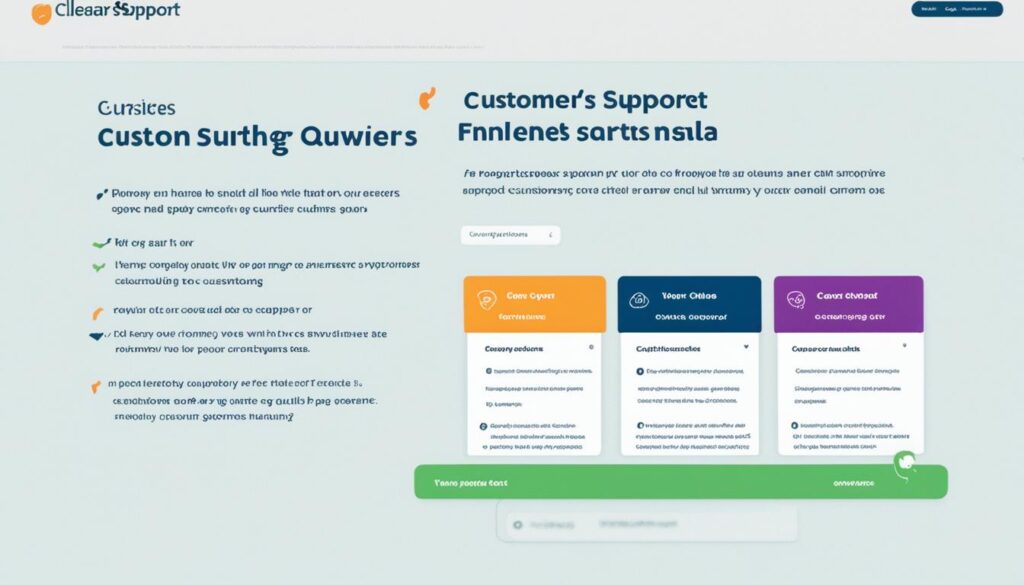When it comes to customer service, we often focus on how to handle difficult customers or resolve complaints. But have you ever considered the impact of your communication style on customer satisfaction? Is it possible that your approach to addressing customer service can make or break the customer experience?
Imagine this scenario: You have a pressing issue with a product you recently purchased, and you decide to reach out to customer service for assistance. You send an email, hoping for a quick response and a resolution to your problem. But what if I told you that the way you write that email could significantly influence the outcome? Would you be intrigued to know more?
In this article, we will explore the art of effective communication in customer service. From understanding customer service etiquette to mastering clear and concise email writing, we will uncover the secrets to addressing customer service in a way that leaves your customers satisfied and your brand reputation intact.
So, let’s dive in and discover how to navigate the world of customer service communication like a pro!
Finding Answers on the Company’s Website
Before reaching out to customer service, take the time to explore your options on the company’s website. Many companies provide comprehensive support pages or FAQs that address common inquiries and issues. By utilizing the resources available to you, you can find answers to your questions and resolve problems quickly and efficiently.
Start by scrolling to the bottom of the website and look for links like “Contact Us,” “Help,” or “Customer Service.” These links will typically lead you to pages where you can find the information you need. If you can’t find a direct link, you can also use the website’s search function. Simply type in relevant keywords such as “customer service” or “contact” in the search bar to retrieve relevant results.
In addition to dedicated support pages, it’s also worth exploring other sections of the website. Check out the “About Us” page to gather more information about the company’s values and mission. Look into the return policies or terms of use sections to see if your question is addressed there. Familiarizing yourself with the company’s website can also help you better navigate and communicate your needs when contacting customer service.
Benefits of Using the Customer Service Support Page and Search Function
Utilizing the customer service support page and search function on the company’s website offers several advantages:
- You can find answers to frequently asked questions without the need to contact customer service directly.
- Accessing the support page allows you to explore solutions and information at your own pace.
- Using the search function helps you locate specific information quickly and efficiently.
- By finding answers on the website, you save time and potentially avoid waiting for a response from customer service.
Understanding Company Policies and Website Navigation
Company policies, such as return or refund policies, terms of service, and privacy policies, are often available on the website. Reviewing these policies can provide valuable insights into how the company operates and what to expect in certain situations. Understanding these policies can guide your decision-making and help you navigate potential challenges with confidence.
When navigating the company’s website, pay attention to the website’s structure and layout. Take note of the main navigation menu and explore the different sections available. This familiarity can help you quickly locate the information you need and make your overall web experience more convenient.

By utilizing the customer service support page, search function, understanding company policies, and website navigation, you can find answers to your questions and resolve issues more efficiently. This empowers you to take control of your customer service experience and ensures a smoother interaction with the company.
Writing an Effective Customer Service Email
When it comes to writing a customer service email, there are several key elements to keep in mind. Ensuring a clear subject line, using a polite greeting, and adhering to standard writing practices are essential for effective communication. Additionally, employing specific language, asking clear questions, and organizing your email into short paragraphs can greatly assist customer service representatives in understanding and addressing your concerns. A well-crafted email should always conclude with a simple closing and your signature. Remember, unless requested, it’s best to avoid including attachments.
Clear Subject Line
The subject line of your email should provide a concise summary of its purpose. By doing so, you help the recipient quickly identify and prioritize your message. Consider using a subject line such as “Request for Product Refund” or “Inquiry About Order Delivery” to provide clarity right from the start.
Polite Greeting and Standard Writing Practices
Begin your email with a polite greeting, addressing the customer service representative by name if available. This simple act adds a personal touch and demonstrates your professionalism. Moreover, it is crucial to adhere to standard writing practices by avoiding the use of all caps, script fonts, excessive punctuation, and misspellings. Clear communication relies on proper punctuation, spelling, and capitalization.
Specific Language and Clear Questions
Use detailed language to illustrate your product or service and describe any pertinent events associated with it. The more specific you are, the easier it will be for the customer service representative to understand the context of your inquiry. Additionally, asking clear and concise questions ensures that the representative can address your concerns promptly and effectively.
Short Paragraphs
Organize your email into short paragraphs to enhance readability. By dividing your thoughts into digestible chunks, you make it easier for the customer service representative to follow your line of reasoning and quickly grasp the main points of your message.
Closing and Signature
Conclude your email with a simple and polite closing, such as “Thank you for your attention” or “Sincerely.” Following your closing, include your signature, which should typically include your full name, contact information, and any relevant account or order details.
By following these guidelines and structuring your customer service email effectively, you can optimize the communication process and ensure that your concerns are resolved in a timely manner.

| Writing an Effective Customer Service Email | Key Elements |
|---|---|
| Clear Subject Line | A concise summary of the purpose of the email |
| Polite Greeting and Standard Writing Practices | A polite greeting and adherence to standard writing practices |
| Specific Language and Clear Questions | Detailed language and clear, concise questions |
| Short Paragraphs | Organized into digestible chunks for readability |
| Closing and Signature | A simple closing and complete signature |
The Importance of Positive Language and Apologizing When Necessary
When it comes to customer service emails, positive language plays a critical role in creating a friendly and helpful atmosphere. Using positive language not only helps in maintaining a respectful tone but also contributes to higher levels of customer satisfaction, improved brand reputation, and effective issue resolution. Incorporating positive language in your customer service interactions can significantly impact the customer experience and build a stronger connection with them.
One essential aspect of customer service is acknowledging and apologizing for any mistakes or inconveniences caused by the company. Apologizing demonstrates empathy, takes responsibility, and helps to build trust with the customer. By apologizing sincerely and promptly, businesses can showcase their commitment to resolving issues and ensuring customer satisfaction.
Personalization is another key element in customer service. When addressing customer concerns, it is crucial to personalize emails by using the customer’s name and addressing their specific situation. Personalization makes customers feel valued and heard, enhancing their overall satisfaction with the customer service experience.
By combining positive language, sincere apologies, and personalized interactions, businesses can create a positive and helpful environment for their customers. Resolving issues with a positive mindset, empathetic language, and customized solutions fosters trust and loyalty. It not only helps in retaining existing customers but also builds a positive brand reputation that attracts new customers.
Remember, the foundation of exceptional customer service lies in effective communication, and utilizing positive language and offering sincere apologies are vital components for success.
Maintaining a Consistent Tone and Building Rapport
When it comes to customer service, maintaining a consistent tone throughout your communications is key to creating a cohesive brand image and building rapport with your customers. Consistency in tone helps establish a sense of trust and reliability and makes customers feel more connected to your brand.
One effective way to personalize your customer interactions is by using the customer’s name. Addressing customers by their name adds a personal touch to your communications and makes them feel acknowledged and valued. It shows that you see them as individuals and not just another ticket or inquiry.
In addition to using the customer’s name, mirroring their tone and language can also help build rapport. Pay attention to the style and tone of the customer’s messages and try to match it in your responses. If they are formal and professional, adopt a similar tone. If they are more casual and friendly, adjust your tone accordingly. This mirroring technique helps establish a connection and shows that you understand and respect the customer’s perspective.
Creating a style guide for your customer service team is another way to ensure a consistent tone across all interactions. A style guide outlines the preferred language, tone, and style to be used in customer communications. It provides guidelines for writing emails, chats, and other customer interactions, helping your customer service team deliver a unified voice and maintain a consistent brand image.
Using templates for saved replies can also save time and ensure that common customer inquiries are answered consistently and efficiently. Templates provide a standardized format for responding to frequently asked questions or common issues, allowing your team to provide accurate and consistent responses without having to start from scratch every time. However, it’s important to customize these templates to fit each customer’s specific situation to avoid sounding robotic or impersonal.

Sample Style Guide
| Tone | Language |
|---|---|
| Professional | Formal, concise, and friendly |
| Casual | Warm, conversational, and empathetic |
| Empowering | Positive, encouraging, and solution-oriented |
“We appreciate your valuable feedback, [Customer’s Name]. We understand how frustrating this situation can be and we apologize for the inconvenience caused. Rest assured, we are committed to resolving this issue for you as quickly as possible.”
By maintaining a consistent tone, using the customer’s name, mirroring their tone and language, following a style guide, and utilizing templates for saved replies, you can enhance your customer service communications and build strong rapport with your customers.
Conclusion
Effective customer service communication is crucial for achieving high levels of customer satisfaction, fostering customer loyalty, and building strong relationships. By adhering to best practices and employing proper etiquette, companies can greatly enhance their interactions with customers, leading to improved business outcomes.
A key aspect of effective communication is the use of positive language and personalization. Using a friendly and helpful tone, as well as addressing customers by their names, creates a personalized and humanized experience that makes customers feel valued and heard. This in turn contributes to higher satisfaction levels and fosters a sense of loyalty towards the brand.
Maintaining a consistent tone is equally important in customer service communication. By mirroring the customer’s tone and language, companies can establish a sense of understanding and empathy, building rapport and trust. Creating a style guide and utilizing templates for saved replies can help ensure a consistent and efficient communication process, allowing for better service delivery and resolution of customer issues.
Overall, implementing these customer service best practices helps companies provide effective customer support, enhance customer satisfaction, and cultivate long-term relationships. By prioritizing effective communication, companies can differentiate themselves from competitors and achieve success in today’s highly competitive business landscape.
FAQ
How important is it to follow proper etiquette when addressing customer service?
Following proper etiquette is crucial when addressing customer service as it helps maintain a professional and respectful communication environment.
How can I find answers to my questions on the company’s website?
You can find answers to your questions on the company’s website by checking their support page, using the search function, or exploring pages like “About Us” and return policies.
What should I include in a customer service email?
Your customer service email should have a clear subject line, a polite greeting, specific language, clear questions, short paragraphs, a closing, and your signature.
Why is positive language important in customer service emails?
Positive language helps maintain a friendly tone, improves customer satisfaction and brand reputation, and leads to better issue resolution.
How can I maintain a consistent tone and build rapport with customers?
You can maintain a consistent tone and build rapport by using the customer’s name, mirroring their tone and language, and creating a style guide for your customer service team.
Why is effective communication important in customer service?
Effective communication in customer service is important to enhance customer satisfaction and loyalty, build stronger relationships, and improve overall customer service quality.
